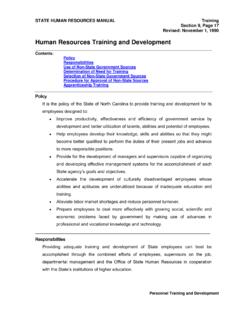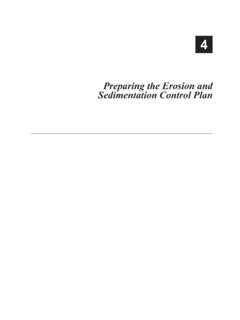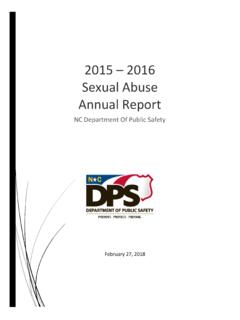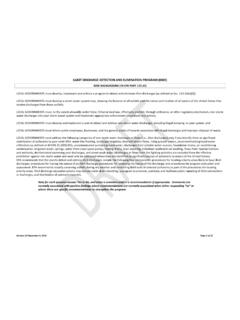Transcription of State of North Carolina - NC
1 State of North Carolina Chapter: F. Department of Public Safety Section: .1500. Title: Use of Force Prisons Issue Date: 08/30/18. Supersedes: 03/26/18. POLICY & PROCEDURES..1501 PURPOSE. The purpose of this policy is to provide Prisons' personnel direction in the use of non-deadly and deadly force, documentation requirements, and reporting procedures for use of force incidents..1502 DEFINITIONS. (a) Escapee -- any individual who leaves or is attempting to leave the custody of Prisons without prior authorization. (b) Deadly (lethal) force -- any use of force that would reasonably tend to result in death or serious bodily injury.
2 (c) Non-Deadly (less than lethal) force -- any use of force that is not likely to result in death or serious bodily injury. (d) Hands on physical force -- any degree of physical force exerted by a staff member using bodily strength including approved unarmed self-defense techniques. (e) Pepper spray -- aerosol spray based on the active natural ingredient oleoresin capsicum , a derivative of various species of cayenne pepper. (f) Chemical Mace -- aerosol spray based on the active chemical ingredient orthochlorobenzalmalonoitrile commonly referred to as CS. (g) Conducted Electronic Weapon (CEW) -- A CEW is a less-lethal device that uses electrical current, with the goal of achieving neuromuscular incapacitation, by the disruption of voluntary control of the muscles.
3 (h) Deploy -- means to fire a CEW cartridge sending the probes downrange. (i) Drive Stun -- means to activate the CEW while holding it against the target, such that the CEW probes make contact with the target. Page 1 of 17 Chapter F .1500. 08/30/18 Use of Force (j) Individual control devices -- include the specific expandable baton and rigid baton as designated in the Standard Equipment list. (k) Mechanical restraints -- include handcuffs, waist chains, leg cuffs, handcuff covers "black box", pad locks, and flex cuffs. (l) Tear gas refers to the formula orthochlorobenzalmalonoitrile, commonly referred to as CS, contained in various dispersion instruments including grenades, projectile, and canisters.
4 Normally used to disperse multiple subjects or in crowd control applications. (m) Probable cause -- reasonable grounds to believe that an offense has been (or is being). committed and that a specific person committed it. (n) Breach of the peace -- a fight, disturbance, shouting, riot or the like. (o) Chemical Munition a less than lethal hand thrown grenade, or a less than lethal munitions fired from either a designated 12 gauge shotgun or 37mm grenade launcher that contains either OC ( oleoresin capsicum ) or CS (orthochlorobenzalmalonoitrile). A chemical munitions is utilized to subdue hostile offenders or quell disturbances by the use of chemical agents with minimal threat of injury.
5 (p) Specialty Impact Munitions a less than lethal hand thrown grenade, or a less than lethal munitions fired from either a designated 12 gauge shotgun or 37 mm grenade launcher that contains foam, rubber or wood batons or rubber pellets. The special impact munitions are designed to utilize impact to cause discomfort to bring hostile and/or disruptive offenders under control. (q) Facility Chemical Officers Correctional sergeants or above who have completed the six hour Duty Chemical Agents and Specialty Impact Munitions lesson plan..1503 POLICY. The following general guidelines apply to the use of force in Prisons.
6 (a) The use of force shall be permissible only to the extent reasonably necessary for a proper correctional objective. This prohibition shall not be construed to mean that staff must suffer an assault upon their person before taking appropriate defensive action or that the use of force by another must be met with strictly equal force on the part of the staff. (b) An officer is authorized to use whatever degree of force that reasonably appears to be necessary to defend the officer or a third party from imminent assault. Reasonable force is authorized in order to prevent an escape or to ensure compliance with a lawful order or to Page 2 of 17 Chapter F.
7 1500. 08/30/18 Use of Force protect property or to return an escapee to custody. When time and circumstances permit, a sergeant or supervisor of higher rank should be present to supervise anticipated use of force or situations likely to result in use of force. An officer should attempt non-forcible methods of offender control, but only to the extent reasonably possible under the circumstances as they appear to that officer. (c) An officer may lawfully utilize deadly force to: (1) prevent the escape of a convicted felon, (2) prevent or stop a life threatening assault on themselves or another person, or (3) prevent escape of a pre-trial detainee awaiting felony charges.
8 (4) Deadly force may not be used solely to protect property or ensure compliance with a lawful order that does not implicate personal safety. (d) An officer is prohibited from using force solely as a result of verbal provocation. An officer shall not use force against an offender who has abandoned his/her resistance or who is effectively restrained. The use of force as punishment is strictly prohibited. (e) When employing any degree of force, the officer shall use reasonable care to ensure that uninvolved persons are not endangered by such use of force. (f) Each facility will designate the posts approved to be routinely issued batons and CEWs.
9 (g) The expandable and rigid batons are the only impact tools authorized for duty use by Prisons personnel. (h) Prisons will maintain a policy and procedure governing the availability, control, and use of chemical agents, and related security devices and specifying the level of authority required for their access and use. Chemical agents are authorized only used with the authorization of the facility head or designee. (i) Firearms will be limited to those approved by the Director of Prisons. Use of a personal firearm is expressly prohibited. All firearms utilized must be the property of Prisons. (j) If an offender complains of a use of force and the use of force was not reported, the Officer- In-Charge will investigate.
10 The investigation should begin with a face to face medical examination as soon as possible. If the Officer-In-Charge determines that a use of force should have been reported and the standard Incident Report completed, the responsible officer will be subject to disciplinary action. Page 3 of 17 Chapter F .1500. 08/30/18 Use of Force (k) Escapes. (1) Deadly force is not authorized against a misdemeanor escapee, a pretrial detainee awaiting misdemeanor charges or in the apprehension of these persons except where there is an imminent threat of death or serious bodily injury presented. (2) Deadly force is authorized against a felon escapee or a pretrial detainee awaiting felony charges.














